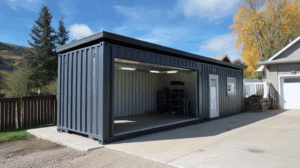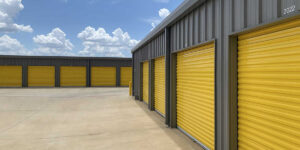Exploring the Economics: How Much Does a Shipping Container Garage Really Cost?
Are you considering building a garage but looking for a cost-effective and sustainable solution? Look no further than a shipping container garage. Shipping containers have gained popularity in recent years for their versatility, affordability, and eco-friendly nature. However, before embarking on this project, it’s essential to understand the economics behind constructing a shipping container garage. In this blog post, we will explore the costs associated with building a shipping container garage, helping you make an informed decision.
The Initial Investment
The first factor to consider when calculating the cost of a shipping container garage is the initial investment. The price of a shipping container can vary depending on various factors such as size, condition, and location. On average, a used shipping container can cost anywhere from $1,500 to $5,000, while a new container can range from $3,000 to $6,000. Keep in mind that larger containers or those in better condition may come with a higher price tag.
Site Preparation
Before you can start constructing your shipping container garage, you need to prepare the site. The site preparation costs will depend on several factors, including the condition of the land, accessibility, and local regulations. Some common expenses during site preparation include clearing the land, leveling the ground, and installing a foundation. The cost of site preparation can vary significantly, ranging from a few hundred dollars to several thousand dollars.
Modifications and Customizations
One of the advantages of using shipping containers as a building material is their adaptability. However, modifications and customizations will add to the overall cost of your shipping container garage. Common modifications include adding windows, doors, insulation, ventilation, and electrical wiring. The cost of modifications will depend on your specific requirements and can range from a few hundred dollars to several thousand dollars. It’s essential to plan out the modifications carefully to avoid any unexpected expenses.
Construction and Labor
Constructing a shipping container garage requires skilled labor and expertise. While some DIY enthusiasts may choose to handle the construction themselves, it’s advisable to hire professionals to ensure a safe and sturdy structure. The cost of labor will depend on the complexity of the project, the number of containers used, and the local labor rates. On average, labor costs for building a shipping container garage can range from $5,000 to $10,000, but this estimate can vary significantly.
Additional Costs
In addition to the essential expenses mentioned above, there are a few additional costs to keep in mind. These costs may include obtaining necessary permits and approvals, transportation of the shipping containers to the site, and any landscaping or finishing touches you desire. It’s crucial to account for these additional expenses when calculating the total cost of your shipping container garage.
Long-Term Savings
While the upfront costs of building a shipping container garage may be comparable to traditional construction methods, one should also consider the long-term savings. Shipping containers are designed to withstand harsh weather conditions, making them highly durable. They require minimal maintenance compared to wood or brick structures, resulting in reduced long-term maintenance costs. Additionally, shipping containers are eco-friendly, promoting sustainability by repurposing existing materials.
Conclusion
In conclusion, building a shipping container garage can be a cost-effective and sustainable solution for homeowners in need of additional storage or parking space. While the initial investment and associated costs may vary depending on various factors, careful planning and budgeting can help you stay within your desired budget. Moreover, the long-term savings and environmental benefits make a shipping container garage an attractive option for those looking for an innovative and budget-friendly building solution. So, if you’re considering a garage project, why not explore the economics of a shipping container garage and discover the possibilities it holds?
Breaking Down the Numbers: Factors That Impact the Cost of a Shipping Container Garage
Shipping container garages have gained popularity in recent years due to their versatility, durability, and cost-effectiveness. Whether you’re looking to create a workshop, storage space, or even a tiny home, using a shipping container can be a great option. However, it’s important to understand the factors that can impact the cost of your shipping container garage. In this section, we will break down the numbers and shed light on the key factors that can affect the overall cost.
Container Size and Condition
The size and condition of the shipping container you choose will significantly impact the cost of your garage. Typically, containers come in standard sizes of 20 or 40 feet in length, with standard heights and widths. The larger the container, the higher the cost. Additionally, the condition of the container plays a role. New or one-trip containers will be more expensive than used ones. However, used containers can still be a great option if they are in good condition and have been thoroughly inspected for any structural issues.
Modifications and Customizations
One of the advantages of using a shipping container for your garage is the ability to customize it to suit your needs. However, keep in mind that modifications and customizations can significantly impact the overall cost. Common modifications include adding windows, doors, insulation, electrical wiring, plumbing, and ventilation systems. Each modification adds to the cost, so it’s important to carefully consider your requirements and budget before making any changes.
Foundation and Site Preparation
Before you can install your shipping container garage, you’ll need to prepare the site and establish a solid foundation. Factors such as the location, soil conditions, and accessibility can impact the cost of site preparation. If your site requires extensive leveling or excavation work, it will add to the overall cost. Additionally, if you live in an area with strict building codes and regulations, you may need to obtain permits, which can also increase the overall expenditure.
Delivery and Installation
Shipping containers are heavy and require specialized equipment for delivery and installation. The cost of transporting your container to the desired location can vary based on the distance, accessibility, and local fees. It’s important to clarify the delivery fees with the supplier before making a purchase. Furthermore, the installation process might require additional equipment, such as cranes or forklifts, depending on the site conditions. These additional costs should also be factored into your budget.
Additional Features and Finishes
If you want to enhance the aesthetics and functionality of your shipping container garage, you may consider additional features and finishes. This could include exterior cladding, roofing, insulation, flooring, and interior finishes. These elements can significantly impact the cost, but they also add value and improve the overall appearance and comfort of your space. It’s important to strike a balance between your desired features and your budget to ensure a successful project.
Labor and Professional Services
While some people choose to DIY their shipping container garage, others prefer to hire professionals to handle the construction and installation process. Labor costs will vary depending on the complexity of the project, the location, and the experience of the professionals. It’s advisable to obtain quotes from multiple contractors to compare prices and ensure you’re getting the best value for your investment.
Conclusion
When planning your shipping container garage, it’s essential to consider these key factors that can impact the cost. By understanding the variables involved, you can make informed decisions and create a garage that meets your needs and budget. Remember to carefully assess your requirements, work with reputable suppliers and contractors, and always prioritize safety and quality. With proper planning and consideration, your shipping container garage can be an affordable and functional addition to your property.
From Budget-Friendly to High-End: Understanding the Range of Shipping Container Garage Costs
If you’re looking for a unique and versatile solution for your garage needs, shipping container garages have become an increasingly popular option. These repurposed shipping containers offer a cost-effective and environmentally friendly alternative to traditional garages. However, it’s important to understand that the cost of a shipping container garage can vary significantly depending on various factors. In this article, we will explore the range of shipping container garage costs, from budget-friendly options to high-end alternatives.
Budget-Friendly Options
For those on a tight budget, there are affordable options available that can transform a shipping container into a functional garage space. The cost of a basic shipping container typically ranges from $1,500 to $5,000, depending on the size and condition of the container. However, keep in mind that additional costs such as delivery, modifications, and installation may need to be factored in.
When it comes to modifications, basic options like adding insulation, ventilation, and electrical wiring can range from $500 to $1,500. These modifications are essential to ensure a comfortable and functional garage space. You may also want to consider adding windows or a roll-up door for better access and natural light, which can add another $500 to $2,000 to the overall cost.
Overall, a budget-friendly shipping container garage can cost anywhere from $3,000 to $10,000, depending on the size, modifications, and additional features you choose.
Mid-Range Options
If you have a bit more flexibility in your budget, you can upgrade your shipping container garage with additional features and design elements. This mid-range option allows for a more customized and aesthetically pleasing garage space while still maintaining a reasonable cost.
In this price range, you can explore options such as installing a higher quality roll-up door or opting for a sliding glass door to enhance the appearance and functionality of your garage. Adding plumbing for a sink or bathroom facilities can also be considered, which can range from $1,000 to $5,000 depending on the complexity of the plumbing system.
You may also choose to invest in higher-end insulation and HVAC systems for better climate control, which can add another $2,000 to $5,000 to the overall cost. Additionally, if you want to create a workshop or storage area within the garage, adding shelving, workbenches, or cabinetry can range from $500 to $2,000.
In this mid-range option, the cost of a shipping container garage can range from $10,000 to $30,000, depending on the size, modifications, and additional features you choose.
High-End Options
For those who want a truly luxurious and high-end shipping container garage, the sky’s the limit. In this price range, you can transform a shipping container into a state-of-the-art garage with top-of-the-line features and finishes.
High-end options may include custom finishes such as exterior cladding, premium flooring, and high-end lighting fixtures. You can also invest in advanced security systems, automation features, and smart home integration to enhance convenience and security.
In terms of design, you can work with architects and designers to create a unique and visually stunning garage that seamlessly blends with your existing property. This level of customization and luxury comes at a higher cost, with prices ranging from $30,000 to $100,000 or more.
It’s important to note that the cost of a high-end shipping container garage can vary significantly based on the level of customization and the specific features you choose. The final price will depend on factors such as the size, materials, finishes, and additional amenities.
Conclusion
Shipping container garages offer a wide range of possibilities, from budget-friendly options to high-end alternatives. Understanding the different cost ranges will help you make an informed decision based on your budget and requirements. Whether you’re looking for a simple and functional space or a luxurious and personalized garage, shipping container garages provide a versatile and eco-friendly solution that can be tailored to your needs.
The Ultimate Guide to Shipping Container Garage Cost: What You Need to Know
If you’re looking for an affordable and versatile solution to create additional space for your vehicles or storage needs, a shipping container garage might be the perfect option for you. Not only are shipping containers readily available and durable, but they can also be converted into functional garages without breaking the bank. In this ultimate guide, we will explore everything you need to know about shipping container garage cost.
Factors Affecting Shipping Container Garage Cost
Before delving into the specifics of pricing, it’s crucial to understand the various factors that can influence the cost of a shipping container garage. These factors include:
Container Size
Shipping containers come in various sizes, with the most common options being 20 feet and 40 feet in length. The larger the container, the higher the cost will be. It’s essential to consider your space requirements and budget when selecting the container size that suits your needs.
Condition of the Container
The condition of the container can significantly impact its cost. New or one-trip containers, which are in excellent condition, will generally be more expensive than used containers. However, used containers can still be a cost-effective option if they are structurally sound and require minimal repairs.
Customizations and Modifications
The cost of a shipping container garage can increase based on the level of customization and modifications required. Common modifications include adding windows, doors, insulation, electrical wiring, ventilation systems, and flooring. The complexity and extent of these modifications will affect the overall cost.
Location and Delivery
The cost of shipping containers can also vary depending on your location. If you live in a remote or less accessible area, the delivery charges may be higher. Additionally, the distance from the container supplier to your property can impact the overall cost of transportation.
Average Shipping Container Garage Cost
While shipping container garage costs can vary significantly depending on the aforementioned factors, we can provide a rough estimate of the average prices to help you plan your budget.
Used Container Garage Cost
For a used shipping container garage, you can expect to pay anywhere between $2,000 to $5,000 for a 20-foot container, and $3,000 to $7,000 for a 40-foot container. These prices typically include minimal modifications such as adding doors and windows, basic insulation, and electrical wiring.
New Container Garage Cost
If you opt for a new shipping container garage, the prices will be higher. On average, a 20-foot container can cost between $4,000 to $7,000, while a 40-foot container can range from $6,000 to $12,000. These prices typically include additional modifications, such as insulation, electrical wiring, and higher-quality finishes.
Customized Container Garage Cost
For those looking for more extensive modifications and customizations, the cost can increase significantly. Depending on the complexity of the project, a customized shipping container garage can cost anywhere from $10,000 to $30,000 or more. These prices include advanced features like climate control, high-end finishes, and additional structural reinforcements.
Additional Costs to Consider
When budgeting for your shipping container garage, it’s essential to factor in additional costs that may arise during the project. Here are a few additional expenses to consider:
-
Foundation: Depending on your location and local regulations, you may need to build a foundation for your shipping container garage. This can range from a simple gravel base to a concrete pad, adding to the overall cost.
-
Permits and Inspections: Before starting your project, it’s crucial to check with your local authorities regarding permits and inspections. These costs can vary depending on your location and the complexity of the project.
-
Delivery and Transportation: The cost of transporting the container to your property will vary depending on the distance and accessibility of your location. Make sure to include these expenses in your budget.
-
Professional Installation: While some DIY enthusiasts may choose to install their shipping container garage themselves, it’s recommended to hire professionals for a seamless and secure installation. The cost of professional installation can vary based on your location and the complexity of the project.
Conclusion
A shipping container garage can provide an affordable and versatile solution for your storage or vehicle needs. By considering factors such as container size, condition, customizations, and location, you can estimate the cost of your shipping container garage project. Remember to account for additional expenses such as foundation, permits, and professional installation to ensure a smooth and successful project. With proper planning and budgeting, you can create a functional and cost-effective shipping container garage to meet your needs.
Maximizing Value: Tips for Estimating and Controlling Shipping Container Garage Costs
When it comes to building a shipping container garage, one of the most crucial aspects to consider is the cost. Estimating and controlling the expenses associated with this project is essential to ensure you get the best value for your investment. To help you make informed decisions and stay within your budget, we have compiled a list of valuable tips for estimating and controlling shipping container garage costs.
1. Plan and Research
Before diving into any construction project, it is imperative to have a well-thought-out plan. Start by defining your objectives and determining the purpose of your shipping container garage. Will it be used solely for vehicle storage, or will it serve as a multi-purpose space? Understanding your requirements will help you make informed decisions throughout the process.
Next, conduct thorough research on shipping container garage designs, materials, and construction techniques. Familiarize yourself with the various options available to determine which will best suit your needs and budget. Additionally, consider seeking advice from professionals or individuals who have already completed similar projects to gain valuable insights.
2. Set a Realistic Budget
Establishing a realistic budget is crucial to avoid any unforeseen financial burdens. Begin by determining how much you are willing to spend on your shipping container garage. Consider all the associated costs, including permits, site preparation, foundation, insulation, electrical wiring, plumbing, and interior finishing.
It is also essential to account for any potential contingencies or unexpected expenses that may arise during the construction process. Setting aside a contingency fund will provide you with a safety net and help you stay within your budget.
3. Choose the Right Shipping Container
Selecting the appropriate shipping container is a significant factor that can impact both the cost and functionality of your garage. Consider factors such as size, condition, and structural integrity when choosing your container. While used containers are generally more affordable, they may require additional repairs or modifications. On the other hand, new containers offer a pristine condition but come at a higher price.
Additionally, explore options for customizing your container to suit your specific needs. This may include adding windows, doors, ventilation systems, or insulation, which will add to the overall cost but enhance the functionality and comfort of your garage.
4. Optimize Energy Efficiency
Energy efficiency is not only environmentally friendly but also cost-effective in the long run. Invest in insulation to regulate the temperature inside your shipping container garage, reducing the need for excessive heating or cooling. This will help you save on energy bills and create a comfortable environment for your vehicles or other belongings.
Consider utilizing natural lighting options, such as skylights or large windows, to minimize the need for artificial lighting during the day. Additionally, explore energy-efficient lighting fixtures and appliances to further reduce your electricity consumption.
5. DIY vs. Hiring Professionals
Deciding whether to take the do-it-yourself (DIY) route or hire professionals to handle the construction is a crucial aspect that can significantly impact your overall costs. While DIY projects may save you money on labor costs, it is essential to assess your skills, experience, and the complexity of the project before making this decision. Remember that mistakes during construction can lead to costly repairs or modifications down the line.
Hiring professionals, such as architects, engineers, and contractors, can provide you with expertise and ensure the project is completed efficiently and up to code. Obtain multiple quotes from reputable professionals and compare them to make an informed decision that aligns with your budget.
6. Time and Project Management
Managing your project effectively can help you control costs and avoid unnecessary delays. Create a detailed timeline and set realistic deadlines for each stage of the construction process. This will help you stay on track and prevent any unexpected expenses due to time overruns.
Additionally, communicate regularly with your contractors or construction team to ensure everyone is on the same page. Frequent updates and progress reports will allow you to address any issues promptly and avoid costly mistakes.
7. Consider Second-Hand Materials
If budget constraints are a significant concern, consider sourcing second-hand materials for your shipping container garage. Many construction salvage yards or online platforms offer used building materials at a fraction of their original cost. These materials can include doors, windows, flooring, or even entire shipping containers. However, ensure that the quality and condition of the materials meet your standards before making a purchase.
8. Think Long-Term
When estimating and controlling shipping container garage costs, it is essential to think beyond the initial construction phase. Consider the long-term maintenance and operational costs associated with your garage. Investing in quality materials and construction techniques may initially be more expensive but can save you money in the long run by reducing repair and replacement expenses.
Regular maintenance, such as inspecting for rust or leaks, can also help prevent costly damages and ensure the longevity of your shipping container garage.
In conclusion, estimating and controlling shipping container garage costs requires careful planning, research, and decision-making. By following these tips and staying within your budget, you can maximize the value of your investment and create a functional and cost-effective space for your vehicles or other needs. Remember to be flexible and open to adjustments along the way, as unexpected challenges or opportunities may arise, impacting your overall costs.




